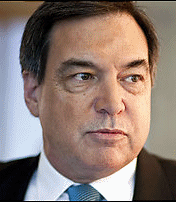
President Obama has stacked his administration with experts and advocates for strong action on global warming and clean energy. Now he has added one more — in an unusually important position as the Washington Post reports:
Add a new name to the list of Obama appointees devoted to aggressive action on climate change.
President Obama yesterday named Jon Wellinghoff — a lawyer who once served as Nevada’s consumer advocate and a believer that electric-car owners could someday get paid to provide backup battery power to the electricity grid — as chairman of the Federal Energy Regulatory Commission.
FERC is especially important because of the role it plays in transmission, a key bottleneck for achieving the clean energy transition (see “smart grids“). As the Post explains, FERC as a long been a backwater on this issue:
Wellinghoff joined the commission in 2006 and has been serving as acting chairman since January. He takes charge of an agency that has long been dominated by oil and gas or utility lawyers and that focuses on the wholesale part of the oil, natural gas and electricity markets. The agency oversees about 368,000 miles of electricity transmission lines and more than 11,000 miles of natural gas pipelines, and regulates hydroelectric projects and energy markets.
But Wellinghoff, who conducted a full energy audit of the shortcomings of FERC’s headquarters soon after he arrived, had previously helped write Nevada’s renewable electricity standard requiring utilities to increase their use of wind, solar and geothermal power. He was the lead attorney for a big solar installation near Las Vegas. And on his windowsill, he keeps a small Stirling engine, a device used in many geothermal and solar installations that runs when it comes in contact with the heat of a hand or computer monitor.
In an interview Thursday, he said climate change would remain “a big priority for me. From everything I’ve read, we’re in big trouble and we need to do everything we can to reduce our carbon footprint.”
How unusual: a FERC head — heck, any serious opinion maker — who actually reads up on the issue of the century. So what does he plan to do?
To do that, Wellinghoff envisions a more sophisticated electricity system with more big transmission lines and a “smart grid” with greater ability to coordinate fluctuations in wind and solar power with the demand from households, buildings and factories.
On Thursday, he supported a proposal that sets rules for smart-grid devices so they can communicate with each other more easily. He is also seeking greater authority over the siting of transmission lines that could carry renewable resources from sparsely populated places where they are plentiful to the cities and suburbs where those resources are most needed.
“How do we do that without steamrolling the states” is a key issue, Wellinghoff said. And while he said that the less FERC intrudes on the power of states the better, he also said that “at the end of the day you need the power to overrule them” in order to make sure that “we get the upgrades done that are essential to the national interest, national security and our environmental interest with respect to carbon and greenhouse gas emissions.”
A recent court ruling, which asserted states’ rights to block transmission lines, could complicate that task. But Senate Majority Leader Harry M. Reid (D-Nev.) favors an increase in FERC’s authority; Senate Energy and Natural Resources Committee Chairman Jeff Bingaman (D-N.M.) plans to push the idea as part of an energy bill.
Another potential conflict was defused this week. The Interior Department and FERC agreed to divide responsibility for regulating offshore alternative energy sources such as wind and wave power, ending a year-and-a-half-long interagency turf battle. Interior will decide on wind power proposals in federal waters, while FERC will oversee wave, tidal and ocean-current projects.
In Wellinghoff’s view, the U.S. electricity system will ultimately become more decentralized, with local solar projects generating power and automobiles serving as storage devices for utility companies. He said that in five to 10 years, if the cost of including the price of household solar installation in a mortgage is less than the money saved on utility bills, “everybody will put solar on their houses.”
And Wellinghoff also understands that plug-in hybrids, are a core climate solution. And electricity is the only alternative fuel that can lead to energy independence.
Ultimately, Wellinghoff hopes to find ways to better manage electricity demand so renewable power sources can be integrated into the system. For instance, he is a proponent of using electric cars to send electricity back to the electrical grid as well as draw from it. Electric-car owners could sign up with a company that would amalgamate hundreds or thousands of car owners and, based on their average behavior, promise to either draw down or send back electricity to the grid. Car owners would be paid, which would help offset the cost of electric vehicles, currently priced at least $8,000 or as much as $12,000 more than non-electric versions.
“It makes the grid more efficient, but it could also benefit vehicle owners because they would be getting money back,” he said.
The value to electric utilities from a plug-in could be $1,000 to $2,000 a year — which in the medium term could be key to very rapid market introduction of plug-ins.
This post was created for ClimateProgress.org, a project of the Center for American Progress Action Fund.


